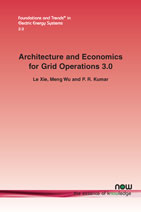Architecture and Economics for Grid Operation 3.0
By Le Xie, Texas A&M University, USA, le.xie@tamu.edu | Meng Wu, Arizona State University, USA, mwu@asu.edu | P. R. Kumar, Texas A&M University, USA, prk.tamu@gmail.com
Abstract
This monograph presents a possible research agenda for analytics and control of a deep decarbonized electric grid with pervasive data, interactive consumers, and power electronics interfaces. It focuses on new lines of investigation that are driven by new technological, economical, and policy factors. Conventional monitoring and control of the power grid heavily depends upon the physical principles of the underlying engineering systems. There is however increasing complexity of the physical models compounded by a lack of precise knowledge of their parameters, as well as new uncertainties arising from behavioral, economic, and environmental aspects. On the other hand there is increasing availability of sensory data in the engineering and economic operations and it becomes attractive to leverage such data to model, monitor, analyze, and potentially close control loops over data. The increasing deployment of large numbers of Phasor Measurement Units (PMUs) provides the potential for providing timely and actionable information about the transmission system. Chapter 2 examines a framework for drastically reducing the dimensionality of the high volume streaming data, while preserving its salient features for purposes such as event detection, classification and visualization, and potentially even to close the loop around the data. Driven by the deepening penetration of renewable energy resources at both transmission and distribution levels, there is an increasing need for utilizing power electronics interfaces as intelligent devices to benefit the overall grid. Chapter 3 offers a conceptual design and concrete examples of a qualitatively different power grid stabilization mechanism in the context of networked microgrids. Another major paradigm change in the operation of the grid is that demand will have to be engaged much more to balance the partially variable renewable energy supply, which in turn requires greater understanding of human behavior to economic variables such as price. Chapter 4 presents a possible formulation to model the behavior of individual consumers in future grid operations. Chapter 5 presents a proposed solution to the problem of detecting attacks on the sensor measurements in the grid, which has become a greater concern with increasing reliance on sensor data transported over communication networks, with both sensors and networks liable to malicious cyber-attacks. The goal of this monograph is to design clean, affordable, reliable, secure, and efficient electricity services. and to expand the horizon of the state of the research in the electric energy systems, at a critical time that is seeing the emergence of Grid 3.0. It is by no means complete and aims to stimulate research by next generation researchers.
Architecture and Economics for Grid Operation 3.0
This monograph presents a possible research agenda for analytics and control of a deep decarbonized energy grid with pervasive data, interactive consumers, and power electronics interfaces. It focuses on new lines of investigation that are driven by new technological, economical, and policy factors. Conventional monitoring and control of the power grid heavily depends upon the physical principles of the underlying engineering systems. There is, however, increasing complexity of the physical models compounded by a lack of precise knowledge of their parameters, as well as new uncertainties arising from behavioral, economic, and environmental aspects. On the other hand, the increasing availability of sensory data in the engineering and economic operations makes it attractive to leverage such data to model, monitor, analyze, and potentially close control loops over data.
The monograph describes the design of clean, affordable, reliable, secure, and efficient electricity services and expands the horizon of the state of the research in the electric energy systems at a critical time that is seeing the emergence of Grid 3.0. It provides an accessible overview of the state-of-the-art aimed at stimulating further research.
The monograph is of interest to all students and researchers working on modern electricity grid problems.
